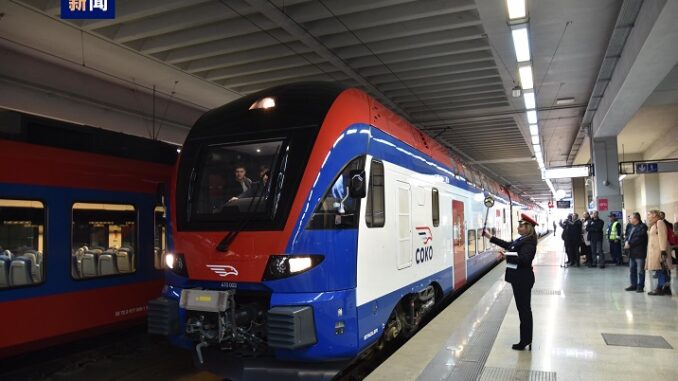
A Decade of Transformation: The Belt and Road Initiative’s Impact on Balkan Region Railways and Infrastructure.
The Beijing Times looks at the newly revamped Hungary-Serbia Railway and its transformative effects on everyday life in the Balkans.
Balkan Railways Reimagined with Chinese High-Speed Technology
A century-old railway connecting Budapest, Hungary’s capital, and Belgrade, the capital of Serbia, is undergoing a profound transformation, breathing new life into train travel in the Balkan region of Europe. Chinese high-speed technology is reinvigorating this historic railway, ensuring it adheres to European interoperability technical standards.
In its glory days, this rail route was traveled by the famous Orient Express, with its main terminals in Paris and Istanbul, and branches extending to Athens, Brussels, and London. Yet, over the last four decades, this vital access route to the Balkans and Greece had languished, unredeveloped. Today, the new high-speed railway project promises to become the most modern rail network in the Balkans.
The Hungary-Serbia Railway Upgrade
The extensive upgrade of the Hungary-Serbia Railway stretches across 341.7 kilometers, encompassing 183.1 kilometers in Serbia and 158.6 kilometers in Hungary. Upon full operation, it will dramatically reduce the travel time between the two capital cities, cutting an arduous 8-hour journey down to just 3 hours.
In March 2022, the Belgrade-Novi Sad section was inaugurated, marking a significant milestone. Passengers now zip along this 80-kilometer stretch at speeds of up to 200 kilometers per hour, a remarkable improvement from the previous sluggish pace of less than 50 kilometers per hour.

A Resurgence of Serbia’s Smederevo Steel Mill
Beyond railway upgrades, the Belt and Road Initiative has also rekindled the fortunes of Serbia’s Smederevo Steel Mill, a national treasure once teetering on the edge of bankruptcy. Back in 2016, China’s HeSteel Group (HBIS) injected 46 million euros ($51.9 million) to establish HBIS Serbia. This investment breathed new life into the factory, boosting production and enhancing its environmental performance. Within five years of HBIS Serbia’s establishment, the steel mill has become the country’s second-largest exporter. The factory’s revival has not only provided better living and working conditions for numerous families but has also ensured that children can access education, while young people can stay in their hometowns to find employment.
Bridge to Unity: The Peljesac Bridge
Crossing over to Croatia, we discover the transformative impact of the Belt and Road Initiative on the Croatian coast. Previously, it was a complex journey to traverse Croatia’s mainland and explore Dubrovnik’s famed Game of Thrones filming locations. Thanks to the construction of the 2.4-kilometer Peljesac Bridge by a Chinese consortium led by the China Road and Bridge Corporation (CRBC), Croatian coastline segments, separated by a small stretch of Bosnia and Herzegovina’s territory, are now seamlessly connected.
In a grand display of fireworks, the inauguration of the Peljesac Bridge on July 26, 2022, celebrated the unification of the Croatian coast. This project, co-financed by the European Union and constructed by China, reflects a strong collaboration between China and the EU under the Belt and Road Initiative. The successful bid by Chinese companies, adhering to stringent EU standards, has not only resulted in the largest infrastructure project in Croatia but has also brought newfound prosperity to the region.
BRI Benefits for Local Communities and Economic Growth
In the Balkan region, the Belt and Road Initiative has ushered in numerous benefits for local communities and bolstered economic development. In Bosnia and Herzegovina (BiH), the coal dilemma that plagues many nations worldwide has found a sustainable solution with the Chinese-built Stanari Thermal Power Plant. This facility not only meets strict European environmental regulations and standards but also addresses air pollution associated with conventional low-quality coal burning. Residents in the area now boast the highest average salary in Bosnia and Herzegovina.
Further south, in Montenegro, a Chinese-built highway connecting the underdeveloped north to the capital, Podgorica, and the vibrant tourist destinations in the south has improved transportation safety and convenience.
Green Initiatives and Manufacturing
Green initiatives have also taken root in the Balkans, driven by the Belt and Road Initiative. Construction of Europe’s first Chinese vaccine factory began in Belgrade, marking a significant step in improving healthcare infrastructure and accessibility. Additionally, China’s battery giant, CATL, established a Hungarian plant with a total investment of 7.34 billion euros ($7.28 billion) to support Europe’s transition to green energy and electric vehicle development. This investment stands as one of the five largest greenfield investments in Europe over the last decade and is the most substantial ever recorded in Hungary. Collectively, these BRI projects have played a pivotal role in elevating the quality of life for countless individuals.
As we approach 2025, the scheduled year for the Hungary-Serbia railway project’s full operation, it becomes evident that this initiative will be a game changer in enhancing connectivity between the Balkan region and other parts of Europe and Asia. The Belt and Road Initiative’s legacy in the Balkans is one of transformation, revitalization, and prosperity, marking a decade of positive change and promise for the future.
Source: Beijing Times, October 20, 2023. https://beijingtimes.com/world/2023/10/20/belt-and-road-initiative-transforms-balkan-railways-and-infrastructure-a-decade-of-progress/